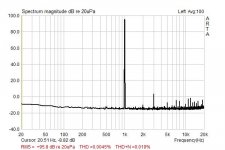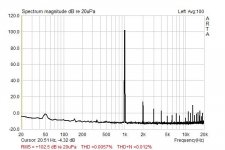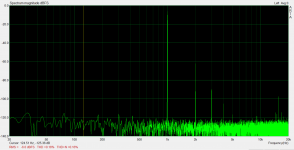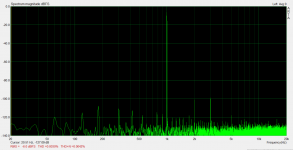What would be a good mic and preamp combo for use with ARTA that can be bought in Canada/USA so I can use dual channel?
The cheapest way would be a dayton emm-6 and a behringer umc22 and using the ”inst2” input for loop back time record
The dayton mic however may not be the flatest mic around
The dayton mic however may not be the flatest mic around
I see the FR compensation does not affect phase. Is it possible and useful to calculate minimum phase from the FR compensation and correct phase too?
The cheapest way would be a dayton emm-6 and a behringer umc22 and using the ”inst2” input for loop back time record
The dayton mic however may not be the flatest mic around
Not really looking for the cheapest, but not gold plated either.
The EMM-6 seems like a common choice for mic.
What about the Focusrite Scarlett-Solo as a preamp?
Thank you,
David.
First I bought the Behringer UMC202HD just to realize the preamp has fairly high distortion in single ended mode, too high for amplifier measurements. I wrote it off and bought a Foscurite Solo, and this one's fine after I got used to its dedicated mic and line/instrument inputs, one each.
I see the FR compensation does not affect phase. Is it possible and useful to calculate minimum phase from the FR compensation and correct phase too?
It depends. Assuming that measurement microphones are minimum phase devices, the phase response can be determined from the gain response. With both gain and phase response available, it is possible to compensate the meausured SPL and phase response. I implemented this in MATAA by deconvolving the raw (uncompensated) impulse response of the speaker with the impulse response of the microphone (as determined from its gain + phase response). This method allows compensating the loudspeaker impulse response for the microphone transfer function.
I don't know much about the compensation approach implemented in ARTA, so I don't know if this is possible with ARTA. Also, some people don't agree with the idea that measurement microphones are minimum phase (although I don't see why), so it is a lot more difficult to determine the phase response of a microphone. The phase response would have to be measured in some way, and I don't know of any practical approach to do this.
Not really looking for the cheapest, but not gold plated either.
The EMM-6 seems like a common choice for mic.
What about the Focusrite Scarlett-Solo as a preamp?
Thank you,
David.
I don't think there's anything wrong with buying cheap stuff as long as they are adequate, for speaker measurements i think the behringer is just fine. If possible I would upgrade the mic, a line audio om1 has a very flat frequency response, but an earthworks m23 or m30 would be a dream to have. But for this kind of money i would instead consider clio pocket for measurement system
What would be a good mic and preamp combo for use with ARTA that can be bought in Canada/USA so I can use dual channel?
The previously mentioned Studio 26c and the EMX-7150 mic..
EMX-7150 Measurement microphone (bulk) - iSEMcon_US
-cheaper mic.s start into higher distortion for extreme near-field measurements for non-linear distortion. A cheaper mic. with a calibration file like the emm-6 is OK if you are a more than a foot away from the driver at typical levels.
For a better (wider bandwidth) calibration file I'd get an EMM-6 from here:
Cross·Spectrum - Calibrated Dayton Audio EMM-6 Microphones for Sale
The UMC20*4*HD is a serviceable cheaper solution than the 26c.. but for the price difference vs. quality I'd go for the Studio 26c.
Thanks. 🙂 That suggests we need flat microphones for measurements for which absolute phase matters. Now I think about it, (absolute) phase of acoustic measurements seems to be irrelevant as long as all measurements have the same error.It depends. Assuming that measurement microphones are minimum phase devices, [...]
I'm yet to see anyone present any evidence that any small electret capsule microphone as typically used for speaker measurement is anything but minimum phase within and well beyond its useful bandwidth.
What would be the theoretical mechanism by which it would become significantly non-minimum phase ?
What would be the theoretical mechanism by which it would become significantly non-minimum phase ?
First I bought the Behringer UMC202HD just to realize the preamp has fairly high distortion in single ended mode, too high for amplifier measurements. I wrote it off and bought a Foscurite Solo, and this one's fine after I got used to its dedicated mic and line/instrument inputs, one each.
I just purchased the Behringer UMC202HD and can confirm that it has relatively high THD (.16) in single ended loop test. I noticed that if you use a RCA to XLR adapter on the input, THD of single ended signal comes down to a reasonable level (.0066). Why would that be?
I still have a few days to return this device. I have been considering the PreSonus 24c.
It was said on the PreSonus forum that only the XLR input goes through the mic preamp. If a TRS connector is used the signal bypasses the mic preamp.
Maybe this is true of the Behringer as well. I could not find that info on the Behringer site.
Maybe this is true of the Behringer as well. I could not find that info on the Behringer site.
i got curious and did a loopback test on a umc22, not stellar in any way but still adequate for acoustic measurements i think
That's pretty good. Are we talking about the same thing, UMC202HD single ended out to single ended inst in?
I just purchased the Behringer UMC202HD and can confirm that it has relatively high THD (.16) in single ended loop test. I noticed that if you use a RCA to XLR adapter on the input, THD of single ended signal comes down to a reasonable level (.0066). Why would that be?
I still have a few days to return this device. I have been considering the PreSonus 24c.
Insteresting find. Problem is, the Mic in is only 3K ohms, it may not be suitable for all purposes.
I've some doubts about their "astonishingly pure, worldclass Midas-designed mic preamps".
That's pretty good. Are we talking about the same thing, UMC202HD single ended out to single ended inst in?
no, my test where for the smaller umc22, line out to line in
below, line out to mik in
Attachments
All the front inputs on the Behringer UMC202HD/UMC204HD go through the preamps.It was said on the PreSonus forum that only the XLR input goes through the mic preamp. If a TRS connector is used the signal bypasses the mic preamp.
Maybe this is true of the Behringer as well. I could not find that info on the Behringer site.
The front TRS inputs can be used in either line level mode or instrument (guitar) mode but in either case it's a balanced input. (Tip is +, ring is -, sleeve is ground)
You can use the TRS input in unbalanced mode by shorting the ring and sleeve but as noted this introduces quite a bit of second harmonic distortion.
The UMC204HD has TRS insert input/outputs on the rear which are unbalanced since the ring is an output from the preamp and the tip is an input to the DAC.
Using the inserts you can input an unbalanced line level signal, and it bypasses the preamps completely which means lower noise and distortion, but also means you can't use the attenuator controls on the front.
This rear input is perfect for loopback measurements such as an impedance measuring jig.
The UMC202HD does not have the rear insert inputs, therefore this "trick" can't be used.
I took some measurements of mine over in this thread:
https://www.diyaudio.com/forums/equ...-audio-interface-measurement.html#post5233173
The summary is that a line level unbalanced signal input via the TRS socket on the front going through the preamps has a 2nd harmonic that is only about 55dB down - not very good.
But the same unbalanced signal input using the insert inputs on the rear has the 2nd harmonic more than 100dB down - which I think is perfectly adequate at the price point...
A floating balanced signal (such as a transformer secondary) on the front TRS inputs also has the 2nd harmonic about 100dB down.
If this high second harmonic distortion on an unbalanced input signal is a problem for you I'd return it. The UMC202HD doesn't have the rear insert inputs that you can use for unbalanced signals like the UMC204HD does.I just purchased the Behringer UMC202HD and can confirm that it has relatively high THD (.16) in single ended loop test. I noticed that if you use a RCA to XLR adapter on the input, THD of single ended signal comes down to a reasonable level (.0066). Why would that be?
I still have a few days to return this device. I have been considering the PreSonus 24c.
The funny thing is at the time I only bought the 204 over the 202 due to the MIDI input/outputs! It was only later I discovered the extra insert inputs at the rear were useful for better quality unbalanced input by bypassing the preamps.
Last edited:
What would be the theoretical mechanism by which it would become significantly non-minimum phase ?
I don't know 🙂
Take a look here and some of the follow up posts. I still think that microphones are minimum phase.
All the front inputs on the Behringer UMC202HD/UMC204HD go through the preamps.
The front TRS inputs can be used in either line level mode or instrument (guitar) mode but in either case it's a balanced input. (Tip is +, ring is -, sleeve is ground)
You can use the TRS input in unbalanced mode by shorting the ring and sleeve but as noted this introduces quite a bit of second harmonic distortion.
The UMC204HD has TRS insert input/outputs on the rear which are unbalanced since the ring is an output from the preamp and the tip is an input to the DAC.
Using the inserts you can input an unbalanced line level signal, and it bypasses the preamps completely which means lower noise and distortion, but also means you can't use the attenuator controls on the front.
This rear input is perfect for loopback measurements such as an impedance measuring jig.
The UMC202HD does not have the rear insert inputs, therefore this "trick" can't be used.
I took some measurements of mine over in this thread:
https://www.diyaudio.com/forums/equ...-audio-interface-measurement.html#post5233173
The summary is that a line level unbalanced signal input via the TRS socket on the front going through the preamps has a 2nd harmonic that is only about 55dB down - not very good.
But the same unbalanced signal input using the insert inputs on the rear has the 2nd harmonic more than 100dB down - which I think is perfectly adequate at the price point...
A floating balanced signal (such as a transformer secondary) on the front TRS inputs also has the 2nd harmonic about 100dB down.
If this high second harmonic distortion on an unbalanced input signal is a problem for you I'd return it. The UMC202HD doesn't have the rear insert inputs that you can use for unbalanced signals like the UMC204HD does.
The funny thing is at the time I only bought the 204 over the 202 due to the MIDI input/outputs! It was only later I discovered the extra insert inputs at the rear were useful for better quality unbalanced input by bypassing the preamps.
Great info, really appreciate your efforts. It still puzzles me though. My cables have 1/4" TS connector on one end and RCA connector at other end which I typically use with a RCA to TS adapter. Changing to an RCA to XLR adapter results in lower THD even though the signal is apparently routed through the microphone preamp. Signal coming from a TS connector must be single ended and the adapter has pin 3 grounded.
Attachments
An RCA to XLR adaptor doesn't sound like a good idea, as the XLR pins are only intended for microphone level signals not line level.Great info, really appreciate your efforts. It still puzzles me though. My cables have 1/4" TS connector on one end and RCA connector at other end which I typically use with a RCA to TS adapter. Changing to an RCA to XLR adapter results in lower THD even though the signal is apparently routed through the microphone preamp. Signal coming from a TS connector must be single ended and the adapter has pin 3 grounded.
The TRS connector can handle either guitar level inputs or line level inputs depending on the button position.
Both XLR and TRS inputs go through an input preamp and are affected by the attenuator knob and pad button, however the XLR input will have more gain.
A normal TS plug with no ring connection would short the negative balanced input to ground, what I haven't tried is using a stereo adaptor but with the ring connection either left floating or connected to ground via a resistor equal to the source impedance of the unbalanced signal. That may be worth trying.
Sometimes when feeding an unbalanced signal into a balanced amplifier terminating the unused input with a resistor to ground (instead of direct connection) whose value is equal to the source impedance provides better balance as it avoids input offset current.
Last edited:



